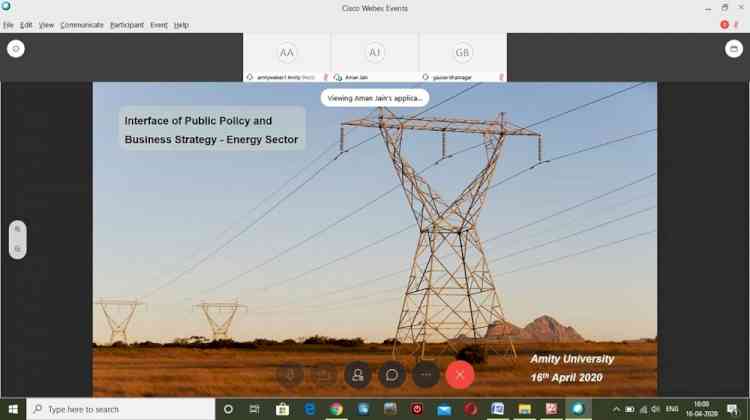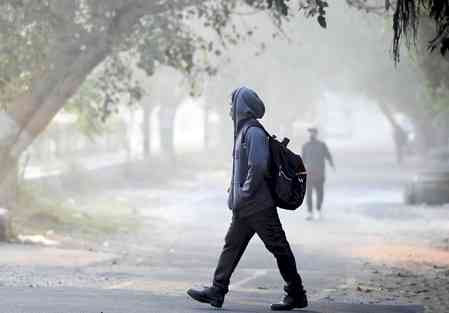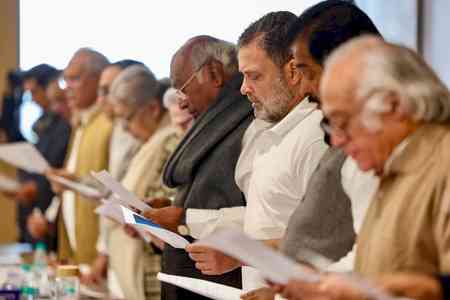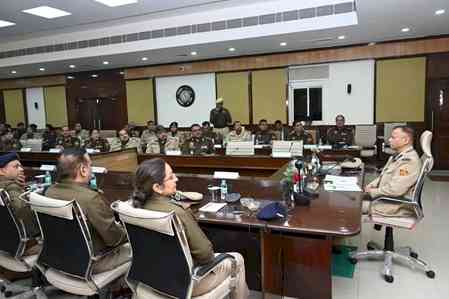Webinars on measures for turbulent times organized at Amity University
Speakers said effective communication is an art of connecting mind and soul

In a bid to keep the flow of knowledge going and enrich the lives of its students, a series of academic and industry-led webinars are being organized at Amity University Uttar Pradesh. Sharing her views on Vital Communication Skills in Times of Turbulence, Ms. Kavita Thapliyal, Associate Professor, AIBS said that effective communication is an art of connecting mind and soul. Dr. Thapliyal briefed about importance of Communication and how it was the most important hope during turbulent times. “Mind is like water. When it’s turbulent, it’s difficult to see. When it’s calm, everything becomes clear. If one is willing to work on it, one can improve quality of every part of life. Disturbed or turbulent time can be divided into three zones or parts: Fear Zone- when hard times comes, fear comes, unverified information tends to circulate thorough different medium of communications; Learning zone – When people starts to cope up with the situation and learn to remain in the environment like starting working from home or online classes etc and Development zone – When we start moving ahead with the circumstances and start taking care of others. It creates bonding in relations,” shared Dr. Thapliyal.
She further stated that every organization must plan for proper communication in times of turbulence which includes internal communication mentioning what organization is expected from each employee. HR department become one of the pivot in these time becoming the face of the company and giving advice to every employee. Dr. Thapliyal said that Communication has great career prospects, good communicator is needed in almost every field like journalism, anchoring, PR, Law, Governance, sales, corporate trainers.
Sharing industry insights, Robinder Singh, Indorama Ventures PCL, Bangkok, Senior Vice President, Regulatory Affairs and Business Development talked about the subject Business as Unusual. Mr. Singh said that current pandemic has created many changes in life of every person. “None can say that are not affected as every country, every region and every person is interconnected. World is getting disruptive but is still dealing with all the restrictions and finding own sets of solutions. Automobile, garment textile, restaurant, tourism and many more companies are worst affected as demand is very low. In reverse, demand in pharma, medical, education, online is sky rocketing. Businesses that are similar to present eco system and are smart enough to continue will benefit most. SAARC, ASEAN regions all are affected and everyone has realized that each country is part of the eco system and association and cannot run alone. Each country has to help individually and also to take care of other regional nations. There is no option but rather to stay safe and follow government instructions, shared Mr. Singh.
In another virtual lecture, Dr. G. Shashikala, Development Medicine Specialist – DEIC, VVH & Sagar Hospitals and Member, Board of Director, IACP talked about ‘Building better brains by improving connectivity & its importance in early intervention’. She also explained students about Neuroplasticity that can be defined as the ability of the nervous system to respond to intrinsic or extrinsic stimuli by recognizing its structure, function and connections. Talking about the important qualities of Neuroplasticity Dr. Shashikala stated that if one doesn’t drive specific brain functions then functional loss will occur. She further elaborated to the students about repetition matters; Intensity matters; time matters; salience matters and age matters as important features of neuroplasticity. Talking about Passive Teaching Methods in the Learning Pyramid, Dr. Shashikala stated that the learning capability increased by 30% through Demonstration; 20% by using audio visual methods; 10% by reading and 5% by lectures.
In another webinar on Interface of Public Policy and Business Strategy - Case Example of Energy Sector by Mr. Aman Jain, Senior Consultant, EY shared that as on March 2020, total installed capacity is 369.4 GW out of which 230.7 GW is generated from conventional sources like coal, gas , diesel etc; 86.8 GW power is generated from renewable sources like Solar, wind, biomass etc, 45.7% is from Hydro and minuscule 6.8 GW is generated from nuclear sources. Conventional sources contribute to 62.3% of the total power generation capacity out of which coal forms 89% of conventional power supply.
“India is still energy and peak power deficit and as per the situation in 2018-19, overall electricity deficit is 0.6% and peak power deficit is 0.8%. Government of India’s 24X7 power for all initiatives include power to all households, industry, commercial businesses, agriculture needs, public needs. To achieve this objective various steps are being taken like – reducing power losses; strengthening the power system; ending human interface in billing process; mandatory installation of prepaid or smart meters to prevent corruption,” said Mr. Jain.
The speaker also demonstrated the increasing trend if emissions from power sector and mentioned that while in year 2015-16, CO2 emission in million tones was 846, it is projected to rise to 1026 by 2021-22 and 1173 by 2026-27. “There is need for de-carbonization. Government of India has made commitments to climate change mitigation in Paris agreement as India is fourth largest CO2 emitter globally responsible for 6% of global CO2 emission after China, US and EU. India as per Nationally Determined Contribution plans to reduce the emission intensity of its GDP by 35% by year 2030; to achieve 40% of electric power installed capacity from non-fossil fuel based energy sources by 2030; to create an additional carbon sink of 2.5 to 3 billion tons of CO2 equivalent through additional forest and tree cover by year 2030. By 2022 India will be producing 175 GW energy from renewable sources – 60GW from wind power; 40GW from Rooftop solar; 60GW from ground mounted; 10GW from biomass and 5GW from small hydro power,” said Mr. Jain.


 cityairnews
cityairnews 










